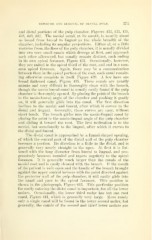Page 725 - My FlipBook
P. 725
EXPOSUKE AND REMOVAL OF DENTAL PULP. 67 [)
and distal ]iortion.s of tlie pulp ehambor, Fic;nres 432, 43;), 435,
438, 440, 442. The mesial canal, at its mouth, is usually about
as broad from buccal to lingual as the whole breadth of the
chamber, includino; its angular ])rojections. Either at, or a little
rootwise from, the floor of the pulj) chamber, it is usually divided
into two very small canals which diverge at first, and approach
each other afterward, but usually remain distinct, each ending
in its own apical foramen. Figure 434. Occasionally, however,
they are united in the apical third of the root, and end in a com-
mon apical foramen. Again, there may be a communication
between them in the apical jjortion of the root, each canal remain-
ing otherwise complete in itself. Figure 439. A few have one
broad flattened canal, Figure 435. These canals are usually
minute and very difficult to thoroughly clean with the broach,
though the mesio-buccal canal is usually easily found if the pulp
chamber is thoroughly opened. By placing the point of the broach
in the mesio-buccal angle of the chamber and pushing it gently
on, it will generally glide into the canal. The first direction
inclines to the mesial and buccal, after which it curves to the
distal and lingual. Generally, these curves are easy, without
short bends. The broach glides into the mesio-lingual canal by
placing the point in the mesio-lingual angle of the pulp chamber
and sliding it toward the root. The first inclination is to the
mesial, but occasionally to the lingual, after which it curves to
the distal and buccal.
The distal canal is approached by a funnel-shaped opening,
of which the central part of the distal wall of the pulp chamber
becomes a portion. Its direction is a little to the distal, and is
generally very nearly straight to the apex. At first it is flat-
tened with the long diameter from buccal to lingual, and pro-
gressively becomes roimded and tapers regularly to the apical
foramen. It is generally much larger than the canals of the
mesial root and is easily cleaned with the broach. If the mouth
of the patient is wide open and the handle of the broach brought
against the upper central incisors with the point directed against
the posterior wall of the pulp chamber, it will easily glide into
the canal and pass to the apical foramen. This position is
shown in the photograph. Figure 443. This particular position
for easily entering the distal canal is important, for all the lower
molars. Occasionally, the lower third molar has but one root
canal. Figure 441, which is generally very large. More rarely
only a single canal will be found in the lower second molar, but
generally, the canals of the second and third lower molars are


